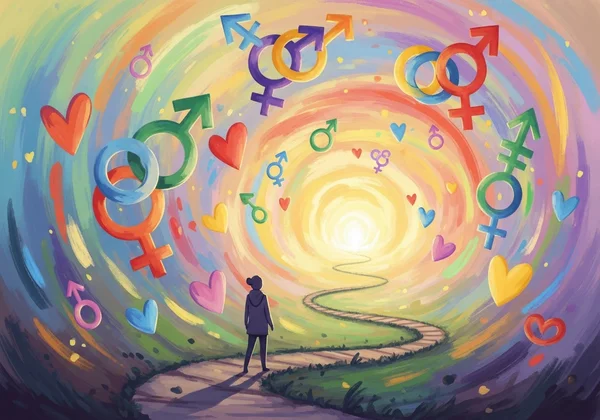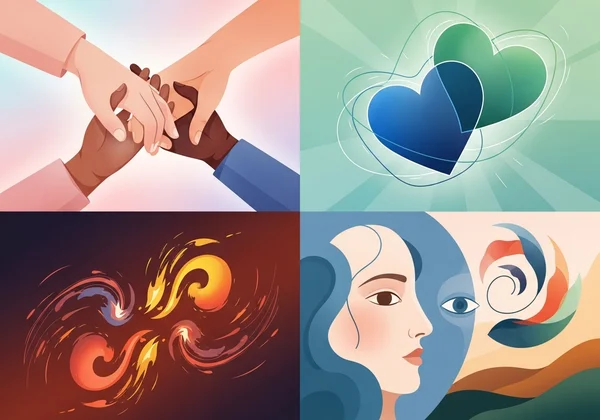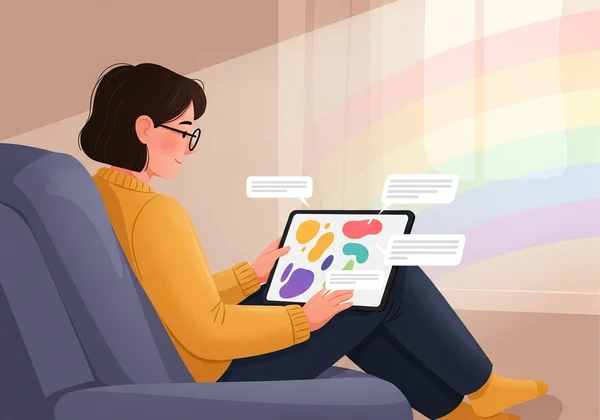Gender Identity vs. Sexual Orientation: Your LGBTQ+ Orientation Quiz Guide
Feeling a swirl of questions about who you are and who you're attracted to? You're not alone. Many people navigate the crucial distinction between gender identity vs sexual orientation. These two vital parts of your self are deeply intertwined yet distinct. This guide will help you confidently and joyfully explore the difference, empowering you on your journey of self-discovery.
Your journey of self-discovery is personal and valid. As you read, remember that this exploration is a brave and wonderful thing. If you find yourself wanting to dive deeper into your patterns of attraction, a helpful next step might be to explore your sexuality with a supportive tool.

What Exactly Is Gender Identity?
At its core, gender identity is your internal, deeply held sense of your own gender. It’s not about what’s written on your birth certificate or what society expects of you based on your anatomy. Instead, it’s a fundamental part of your consciousness—an innate knowing of who you are. This feeling is entirely separate from who you find yourself drawn to romantically or sexually.
Think of it as the internal compass that points to your personal north. It’s about how you see yourself and how you feel inside. For many people, their gender identity aligns with the sex they were assigned at birth; these individuals are called cisgender. For others, their gender identity is different from their assigned sex, and they may identify as transgender, non-binary, or another gender identity.

It's About Who You Are, Not Who You Love
The most straightforward way to grasp this concept is to remember this simple phrase. Gender identity is about your personal relationship with yourself. It’s the name you feel best suits you, the pronouns (like he/him, she/her, or they/them) that feel right, and the way you wish to present yourself to the world. It’s an internal monologue, not a dialogue with someone else.
For example, a person can identify as a man (his gender identity) and be attracted to other men (his sexual orientation). Another person can identify as a woman (her gender identity) and be attracted to men (her sexual orientation). The two concepts operate on different planes of human experience. Clarifying this distinction is a huge step in untangling any confusion you might feel.
Beyond Binary: Exploring Non-Binary and Trans Identities
For a long time, many cultures only acknowledged two genders: man and woman. This is known as the gender binary. However, human experience is far more diverse and beautiful than that. Many people's personal identities don't fit neatly into those two boxes.
- Transgender (often shortened to trans) is an umbrella term for people whose gender identity differs from the sex they were assigned at birth. A trans woman is a woman who was assigned male at birth, and a trans man is a man who was assigned female at birth.
- Non-binary is another umbrella term for gender identities that are not exclusively masculine or feminine. A non-binary person might identify as having two or more genders, no gender at all (agender), a fluid gender that changes over time (genderfluid), or another identity entirely.
Recognizing this spectrum is crucial. It affirms that there is no one "right" way to have a gender. Your feelings are valid, whether they fit within the binary or exist wonderfully beyond it.
Decoding Your Sexual Orientation: Who Are You Attracted To? (Am I Gay? Am I Bisexual?)
If gender identity is your internal sense of self, then sexual orientation is about your external feelings of attraction toward other people. It describes who you are emotionally, romantically, and/or sexually drawn to. This is where terms like gay, lesbian, bisexual, straight, and asexual come into play.
Your sexual orientation is a core part of your identity, describing the pattern of your attractions. It’s not a choice, but rather an intrinsic part of who you are. For those trying to understand this part of themselves, a self-discovery tool can be a gentle starting point to reflect on these feelings in a private, judgment-free space.
Attraction Explained: Different Kinds of Love
Attraction itself is not one-dimensional; it’s a rich and varied experience. Understanding its different forms can bring incredible clarity to your feelings. While these often overlap, they can also exist independently.
-
Sexual Attraction: This is a desire for sexual contact or intimacy with another person.
-
Romantic Attraction: This involves a desire for a romantic relationship with someone, which might include emotional intimacy, companionship, and affection, but not necessarily a sexual component.
-
Emotional Attraction: This is the desire to get to know someone and connect with them on a deep emotional level, often as a close friend.
-
Aesthetic Attraction: This is appreciating someone's appearance or beauty without having a sexual or romantic desire for them.

Recognizing these nuances helps you understand that being drawn to someone doesn't always fit into one simple category. Your pattern of these attractions is what forms your unique sexual orientation.
Is It Normal to Question Your Sexuality? Taking an Online Gay Test
Absolutely. Questioning your sexuality is not only normal but also a healthy and courageous part of self-discovery. Life is not static, and neither are we. People grow, learn, and evolve, and it's natural for your understanding of yourself to evolve too.
Many people question their sexuality at some point in their lives, especially during their teenage years and young adulthood, but it can happen at any age. It’s a sign that you are self-aware and introspective. This questioning phase is an opportunity to listen to your feelings without judgment. If this is where you are now, consider it a journey, not a test. A great way to begin is by taking a free orientation quiz designed to help you reflect.
Why This Distinction Matters for Your Self-Discovery Journey
Understanding the difference between gender identity and sexual orientation is more than just a lesson in vocabulary—it's a foundational act of self-compassion and empowerment. When you can correctly identify the source of your feelings, you can begin to understand them with much greater clarity. This clarity reduces anxiety and builds self-confidence.
Confusing the two can lead to feeling "broken" or "weird," when in reality, you are just trying to use the wrong map for your journey. Separating them allows you to explore each part of yourself independently, giving each the space and attention it deserves.
Finding the Right Labels for Your Feelings
For some, finding a label like "non-binary," "bisexual," or "gay" can feel like coming home. It provides a sense of community and a shorthand to explain a complex internal experience to the world. A label can be a validating and empowering tool, assuring you that you are not alone in your feelings.
However, labels are descriptive, not prescriptive. They are there to serve you, not the other way around. If you don't find a label that fits, or if you prefer not to use one at all, that is completely valid. The ultimate goal is not to fit into a box but to understand and accept yourself. Your journey is yours to define.
Navigating Your Identity Safely and Confidently
Your self-discovery journey should be a safe and affirming experience. As you explore these deep parts of yourself, prioritize your well-being. Surround yourself with supportive people if you can, and seek out resources that speak to you with kindness and respect.
Remember that you are in control of your journey. You get to decide who you share it with and when. There is no timeline or deadline for figuring things out. Give yourself grace, patience, and the same kindness you would offer a dear friend. This exploration is a testament to your strength. As you move forward, resources like an online gay test can offer a private space for reflection.

Empower Your Exploration: Embrace Your Whole Self
Embracing your whole self starts with understanding. When you clarify the difference between your gender identity (who you are) and your sexual orientation (who you're attracted to), you unlock a deeper, more authentic understanding of yourself. This is your journey, and every question you ask builds deeper self-knowledge. Be patient, be compassionate, and allow yourself the space to explore. Ready to dive deeper into your orientation? Start your journey with us. We offer a safe, confidential, and affirming space designed to help you understand your feelings, without judgment.
Frequently Asked Questions About Identity & Orientation
Is it normal to question my sexuality?
Yes, it is completely normal and very common. Questioning your sexuality is a healthy sign of self-awareness. Many people explore their feelings about attraction throughout their lives, and this exploration is a valid part of anyone's journey.
What does it mean to be queer?
"Queer" is an umbrella term that many people in the LGBTQ+ community use to describe a non-straight sexual orientation or a non-cisgender gender identity. It has been reclaimed from a derogatory past and is now often used as a unifying and empowering term that celebrates fluidity and resists rigid labels.
Can my sexual orientation change over time?
Yes, for some people, sexual orientation can be fluid and change over time. This concept is often referred to as "sexual fluidity." It is a valid and recognized experience. What matters most is honoring how you feel in the present moment, without pressure for it to remain the same forever.
What is the difference between gay and bisexual?
A person who identifies as gay is romantically and/or sexually attracted to people of the same gender. A person who identifies as bisexual is attracted to more than one gender. For a deeper, personalized reflection on your own attractions, you might find it helpful to take our quiz.